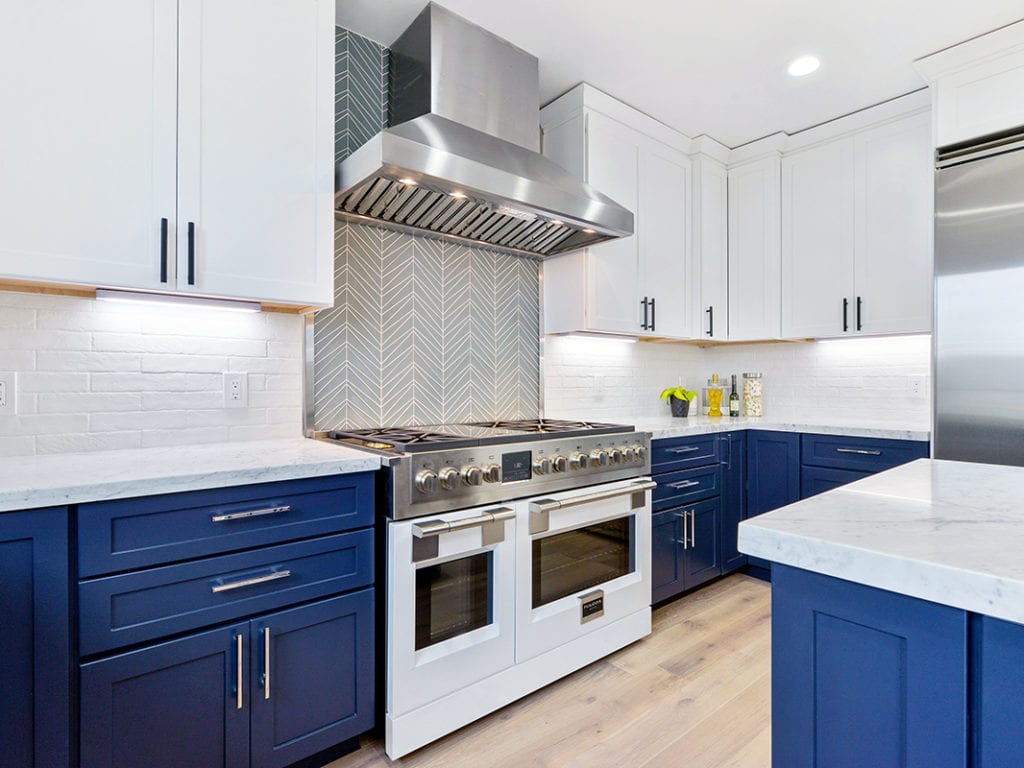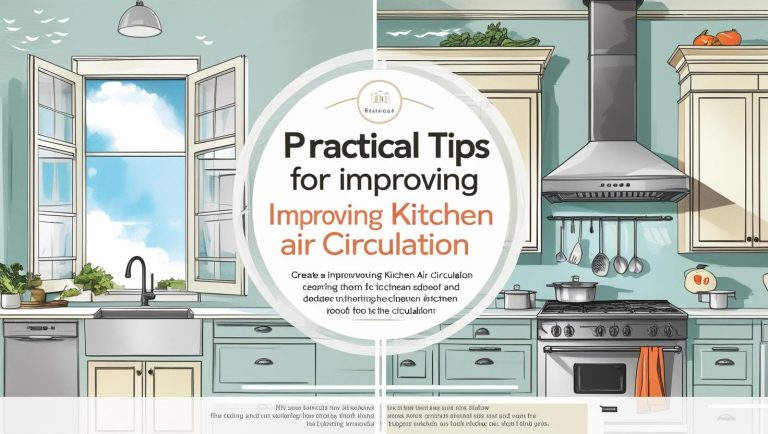If you’re like me, spending time in the kitchen is one of the most important parts of your day. But let’s be honest—sometimes it can feel a bit stuffy, right? Between the cooking smells, steam, and heat, the kitchen can turn into a mini sauna if the air circulation isn’t on point. I know how frustrating it can be because, after all, no one wants to cook dinner in a room that feels like an oven.
I remember a few months ago, I tried making a big pot of chili. The kitchen quickly filled with smoke and steam, and even with the windows open, it felt like I couldn’t get enough airflow. I reached out to my friend Sarah Whitmore, who’s my go-to fact-checker, for some insight on how to improve air circulation. We found that my range hood wasn’t working as efficiently as it should have been. After a few simple changes—like upgrading my exhaust fan and using ceiling fans—I finally got that fresh air back!
So, let’s dive into how you can improve your kitchen air circulation too. You don’t need to be a DIY expert to get better airflow and make your cooking space more comfortable. Keep reading for easy-to-follow tips that’ll make a big difference.
1. Why Good Kitchen Air Circulation Matters?
If you’re like me, you’ve probably noticed how important good air circulation is in your kitchen. It’s not just about keeping your space comfortable, but also about maintaining a clean and healthy environment for you and your family. Here’s why good air circulation matters:
Reduces Moisture and Humidity:
When cooking, especially boiling, steaming, or frying, moisture tends to build up in the air. Without proper ventilation, this moisture can lead to increased humidity levels, creating a breeding ground for mold and mildew. Not only does this affect your health, but it can also cause damage to your kitchen surfaces. Proper air circulation helps reduce these moisture levels, keeping your kitchen dry and safe.
Minimizes Odors:
Cooking odors can quickly linger, and no one wants to walk into a kitchen that smells like last night’s dinner. A well-ventilated kitchen helps remove those lingering smells, keeping your space fresh. Whether you’re making a delicious curry or just reheating leftovers, proper airflow helps ensure your kitchen doesn’t become a smelly zone.
Improves Indoor Air Quality:
Good air circulation helps remove airborne pollutants like smoke, grease, and cooking fumes. These can contribute to poor indoor air quality, which may lead to respiratory issues or aggravate allergies. By ensuring air can circulate properly, you’re not just improving the comfort of your kitchen but also the overall health of your home. The CDC and EPA recommend adequate ventilation to improve indoor air quality and reduce exposure to harmful pollutants.
Enhances Cooking Efficiency:
When there’s enough airflow, your cooking process can become smoother. Smoke, steam, and heat are quickly removed, allowing you to cook without constantly dealing with foggy windows or hazy air. This makes cooking more efficient, and it also creates a more pleasant experience while you prepare your meals.
Good air circulation is essential, not only for comfort but for the health and longevity of your kitchen. By ensuring that your kitchen is well-ventilated, you’re creating a more enjoyable cooking space for everyone in the house.
3. Practical Tips to Improve Kitchen Air Circulation
Improving kitchen air circulation doesn’t have to be complicated. With a few simple adjustments, you can make a huge difference in the air quality and comfort of your kitchen. Let’s dive into some practical tips you can start using today.

3.1. Install a High-Quality Range Hood
One of the most effective ways to improve air circulation in the kitchen is by installing a range hood. A good range hood will remove smoke, steam, grease, and odors from the air, preventing them from spreading throughout your home. Without a proper range hood, these particles can build up on your kitchen surfaces and in the air, creating a sticky, unpleasant atmosphere.
Key Tip: Choose a range hood with the right power for your kitchen size. The CFM (cubic feet per minute) rating tells you how much air the range hood can move, so make sure it’s strong enough to handle the volume of air needed for your cooking space. For small kitchens, a lower CFM is fine, but larger kitchens with high-powered stoves need more ventilation power.
3.2. Open Windows and Doors
Sometimes, the easiest way to improve kitchen air circulation is to open the windows and doors. Natural airflow can do wonders to refresh your kitchen by pushing out stale air and allowing fresh air to come in.
Tip: Open windows and doors on opposite sides of your kitchen to create a cross-breeze. This will help air flow freely throughout the space, reducing humidity and steam while keeping the air fresh. On days when the weather’s nice, this simple act can make a world of difference!
3.3. Use Exhaust Fans Properly
Exhaust fans are designed to help pull the heat, moisture, and smoke out of your kitchen. But, they can’t do their job effectively if they’re not used correctly. These fans help keep the air cool and dry, which is crucial for maintaining a comfortable kitchen environment.
Tip: Make sure your exhaust fans are in good working condition, and remember to use them whenever you’re cooking. They work best when they’re used throughout the cooking process, not just at the end. Also, don’t forget to clean the exhaust fan regularly to ensure it operates efficiently.
3.4. Use Ceiling Fans or Stand Fans
Ceiling fans and stand fans help circulate air, which can prevent warm air from building up near the ceiling. By keeping the air moving, fans ensure that heat, smoke, and steam are distributed evenly throughout the space, making your kitchen feel cooler and fresher.
Tip: Ensure that your fans are directed toward areas where the air tends to get stagnant, like near the stove or in the corners of the room. Adjust the fan settings so that air is moving in the right direction to push out the hot air while drawing in cooler air.
3.5. Install Air Vents or Air Fresheners
If you’re looking for more ways to improve airflow, consider installing additional air vents in the kitchen doors or walls. These vents can help promote natural airflow and ensure that fresh air moves freely throughout the kitchen.
Air Fresheners: If you’re dealing with persistent odors, air fresheners can help, but make sure you choose natural options like houseplants or essential oils. These help improve air quality without introducing chemicals into the air. Plus, houseplants like peace lilies or spider plants can also help filter the air and provide a natural source of oxygen.
3.6. Keep Your Kitchen Clean
A clean kitchen is a healthy kitchen—and it also contributes to better air circulation. Grease buildup, food residue, and clutter can restrict airflow and even create a breeding ground for bacteria. Keeping your kitchen surfaces and appliances clean ensures that air can flow freely throughout the room.
Tip: Regularly clean your kitchen, especially the stove and exhaust hood, where grease and food particles can accumulate. You’d be surprised how much cleaner air feels when the kitchen is tidy and free of buildup!
3.7. Consider an Air Purifier
If you’re dealing with cooking smells, allergens, or even smoke, an air purifier can help clean the air in your kitchen. These devices filter out dust, pollen, smoke particles, and other pollutants, improving the overall air quality in your home.
Tip: Choose an air purifier with a HEPA filter, which is designed to trap even the smallest particles. Place it in areas with high cooking activity to maximize its effectiveness.
4. Regular Maintenance Tips to Keep Airflow Optimal
It’s one thing to make improvements to your kitchen’s air circulation, but it’s also important to keep everything in top shape. Regular maintenance ensures that your kitchen remains fresh and comfortable.
Clean Range Hood Filters:
Over time, grease and grime can build up in your range hood filters, reducing its ability to remove smoke and odors. Make sure to clean or replace the filters regularly (about once a month, depending on how often you cook).
Check Exhaust Fan Vents:
Exhaust fans need regular attention to ensure they’re working properly. Check the vents to make sure they’re clear of dust and debris. Blocked vents will make the fan less effective, so clean them at least once a year to keep everything running smoothly.
Inspect Ductwork:
If your kitchen has ducted ventilation, it’s important to check the ducts for any blockages or damage. Even a small obstruction can drastically reduce the efficiency of your ventilation system. A yearly inspection can help prevent any issues from arising.
Replace Old Appliances:
If your range hood or exhaust fan is over 10 years old and isn’t performing well, it might be time to consider replacing it. Old appliances may not be as efficient, and upgrading them can improve airflow significantly.
Keep Your Windows and Doors in Good Condition:
It’s easy to forget about your windows and doors, but they play a big role in maintaining proper airflow. Ensure that seals are intact and that nothing is blocking the windows or doors. Even small cracks or debris can prevent proper ventilation.
6. Additional Considerations for Better Kitchen Air Quality
Improving air circulation is just one piece of the puzzle when it comes to creating a healthier, more comfortable kitchen. Here are a few additional considerations to enhance air quality even further:
Upgrade Insulation
Good insulation can make a big difference in controlling your kitchen’s temperature and air quality. It helps maintain consistent air pressure inside your kitchen, ensuring that the air doesn’t become stale or overly humid. If your home isn’t well-insulated, you might want to consider upgrading it to keep the kitchen’s temperature and air quality balanced.
Regular Maintenance
Just like any other system in your home, regular maintenance is key to ensuring that your kitchen’s air circulation stays optimal. Be sure to clean your air ducts, range hood filters, and exhaust fans on a regular basis. This prevents dust, grease, and debris from clogging up your systems, allowing them to function effectively and efficiently.
Choose Non-toxic Cookware
What you cook with can also affect the air quality in your kitchen. Some cookware, like cheap nonstick pans, can release harmful chemicals when heated, adding toxins to the air. Consider investing in high-quality, non-toxic cookware, such as stainless steel, cast iron, or ceramic, which won’t release harmful fumes during cooking.
7. Troubleshooting Common Air Circulation Problems
Even with all the right systems and equipment in place, you may occasionally face some air circulation issues. Here’s what to check if your kitchen still feels stuffy:
Check for Hidden Airflow Blockages
Sometimes, the problem can be as simple as furniture or large appliances blocking air vents. Take a moment to assess your kitchen and make sure nothing is obstructing the airflow. Even small objects like curtains or large pots can block vents and prevent the air from circulating properly.
Ensure Your Kitchen Appliances Are Up-to-Date
Older appliances, especially range hoods and exhaust fans, can become less effective over time. If you’ve been using the same equipment for years, it might be time to upgrade to a more efficient model that provides better ventilation. Make sure your appliances are still performing at their best by regularly inspecting them and replacing them as needed.
5. When to Call an Expert
While many air circulation issues in the kitchen can be solved with some DIY fixes, there are times when it’s best to call in a professional to ensure that everything is running smoothly. Here are a few situations when it’s time to bring in an expert:
Persistent Airflow Issues
If you’ve tried all the tips and tricks above and your kitchen still feels stuffy, or if you can’t seem to get enough airflow, it may be time to consult an expert. Sometimes, airflow problems are more complex than what meets the eye, and a professional can identify the root cause and offer more effective solutions.
Broken or Inefficient Ventilation Systems
If your range hood, exhaust fan, or any other ventilation system isn’t working properly, it can severely affect air circulation in the kitchen. While some minor repairs might be easy to handle on your own, a professional can help assess whether repairs or replacements are necessary. They can also ensure that your new equipment is the right size and power for your space.
Structural or Layout Concerns
Sometimes, poor airflow is a result of how your kitchen is laid out or due to issues with the overall home’s ventilation system. For example, if your kitchen is situated in a way that blocks natural airflow or if the ventilation system for your entire home is outdated, fixing the layout might require professional help. A skilled expert can evaluate your kitchen’s layout and offer tailored solutions, from adjusting your kitchen’s design to installing new vents.
Air Quality Concerns
If you notice persistent odors, increasing humidity, or even mold or mildew growing in your kitchen, it may be time to call an expert. These are signs that the air quality in your kitchen is compromised and that the airflow is inadequate. A professional can evaluate the situation and recommend the best course of action, whether it’s installing new ventilation or addressing potential leaks or moisture problems.
FAQs
1. Why is air circulation important in my kitchen?
Good air circulation is key to keeping your kitchen comfortable, safe, and healthy. It helps remove excess moisture, prevents the buildup of cooking odors, and improves air quality by getting rid of smoke and steam. Plus, it makes cooking easier by reducing heat and humidity, so you can focus on creating your best meals without dealing with a stuffy kitchen!
2. How do I know if my range hood is working properly?
If your kitchen still feels hot and smoky after cooking, your range hood may not be doing its job. Check the suction power (CFM rating) and see if it’s pulling air effectively. If you notice a lot of grease buildup or strong cooking odors lingering, it might be time to clean or replace the filter. A properly working range hood should quickly remove smoke and steam as you cook, keeping your kitchen air fresh and clear.
3. Can I improve my kitchen’s air circulation without a range hood?
Absolutely! While a range hood is ideal, there are other ways to boost kitchen air circulation. Open windows and doors to let fresh air in, use exhaust fans to draw out steam and heat, or install ceiling fans to keep the air moving. Regular cleaning and installing air vents can also help improve airflow without the need for a range hood.
4. How often should I clean my kitchen exhaust fan?
It’s a good idea to clean your exhaust fan and range hood filters at least once a month, especially if you cook often. Grease and food particles can build up and reduce the effectiveness of your fan. If you notice your fan is making more noise than usual or it’s not venting steam properly, that’s a sign it’s time for a good cleaning.
5. When should I call a professional to improve kitchen air circulation?
If you’ve tried DIY fixes like cleaning your fan or adjusting your kitchen layout and you’re still dealing with stuffy air, it might be time to call an expert. A professional can check if your ventilation system is working properly or if you need a bigger upgrade, like replacing your range hood or adjusting your kitchen’s layout for better airflow. They can also help with more serious issues, like mold or moisture buildup, ensuring your kitchen is both comfortable and safe.
Conclusion
Improving kitchen air circulation isn’t just about comfort—it’s about creating a healthier, safer space for you and your family. By following the tips and tricks in this guide, you can significantly reduce moisture, odors, and heat, making your kitchen a more pleasant place to cook and spend time in.
Remember, it’s all about consistent effort. Keep your range hood clean, use fans and exhaust systems regularly, and be sure to maintain your equipment. By staying on top of these tasks, your kitchen will always have fresh air flowing and will be ready for whatever meal you decide to cook.
If you’re still facing issues, don’t hesitate to call in a professional who can offer personalized solutions to improve your kitchen’s air circulation.
References
- 8 Kitchen Ventilation Ideas and Solutions For Cleaner Air, https://us.fotileglobal.com/pages/how-to-improve-kitchen-ventilation-in-5-steps
- Essential Air Quality Tips for Safe Kitchens, https://getuhoo.com/blog/home/essential-air-quality-tips-for-safe-kitchens/
- EXPERT VENTILATION METHODSFOR HOME, https://www.daikin.com/air/daikin_techknowledge/ventilation
- The Importance of Kitchen Ventilation and Why Ventilation is as Important as the Cleanliness, https://themeptimes.com/the-importance-of-kitchen-ventilation-and-why-ventilation-is-as-important-as-the-cleanliness/
- 5 Surprising Benefits of Proper Kitchen Ventilation, https://hauslane.com/blogs/resources/5-surprising-benefits-of-proper-kitchen-ventilation
- Why is it important to have ventilation in the kitchen?, https://www.quora.com/Why-is-it-important-to-have-ventilation-in-the-kitchen



